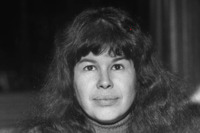- Αγγλικά
-
- n 79045539 ⟶ Detroit (Mich.)
-
- Q12439 ⟶ Detroit
-
- 133676653 ⟶ Detroitas (Mičigano valstija)
-
-
Detroit (/dɪˈtrɔɪt/, dih-TROYT; locally also /ˈdiːtrɔɪt/, DEE-troyt)[8] is the most populous city in the U.S. state of Michigan. It is the largest U.S. city on the United States–Canada border, and the seat of government of Wayne County. Detroit had a population of 639,111 at the 2020 census,[9] making it the 29th-most populous city in the United States. Detroit experienced a dramatic decline in population from a peak of 1,849,568 in 1950, losing two-thirds of its population (65.4%) by 2020. The Metro Detroit area, home to 4.3 million people, is the second-largest in the Midwest after the Chicago metropolitan area and the 14th-largest in the United States. A significant cultural center, Detroit is known for its contributions to music, art, architecture, and design, in addition to its historical automotive background.[10][11]
In 1701, Antoine de la Mothe Cadillac and Alphonse de Tonty founded Fort Pontchartrain du Détroit. During the late 19th and early 20th century, it became an important industrial hub at the center of the Great Lakes region. The city's population rose to be the fourth-largest in the nation by 1920, after New York City, Chicago, and Philadelphia, with the expansion of the automotive industry in the early 20th century.[12] The Detroit River became the busiest commercial hub in the world as it carried over 65 million tons of shipping commerce each year. In the mid-20th century, Detroit entered a state of urban decay which has continued to the present, as a result of industrial restructuring, the loss of jobs in the auto industry, and rapid suburbanization. Since reaching a peak of 1.85 million at the 1950 census, Detroit's population has declined by more than 65 percent.[9] In 2013, Detroit became the largest U.S. city to file for bankruptcy, which it successfully exited in December 2014.[13]
Detroit is a port on the Detroit River, one of the four major straits that connect the Great Lakes system to the St. Lawrence Seaway. The city anchors the second-largest regional economy in the Midwest and the 14th-largest in the United States.[14] Detroit is best known as the center of the U.S. automotive industry, and the "Big Three" auto manufacturers—General Motors, Ford, and Stellantis North America (Chrysler)—are all headquartered in Metro Detroit.[15] The Detroit Metropolitan Airport is among the most important hub airports in the United States. Detroit and its neighboring Canadian city Windsor constitute the second-busiest international crossing in North America, after San Diego–Tijuana.[16]
Detroit's diverse culture has had both local and international influence, particularly in music, with the city giving rise to the genres of Motown and techno and playing an important role in the development of jazz, hip-hop, rock, and punk. The rapid growth of Detroit in its boom years resulted in a globally unique stock of architectural monuments and historic places. Since the 2000s, conservation efforts have managed to save many architectural pieces and achieve several large-scale revitalizations, including the restoration of several historic theaters and entertainment venues, high-rise renovations, new sports stadiums, and a riverfront revitalization project.
An increasingly popular tourist destination, Detroit receives 16 million visitors per year.[17] In 2015, Detroit was named a "City of Design" by UNESCO, the first U.S. city to receive that designation.[18]
⟶ Wikipedia
-

